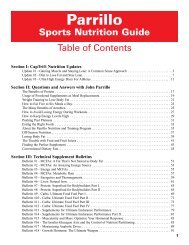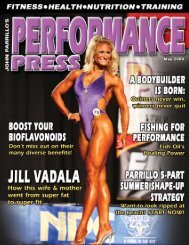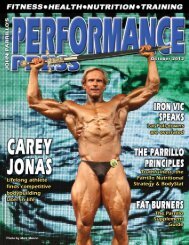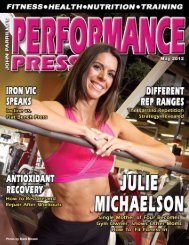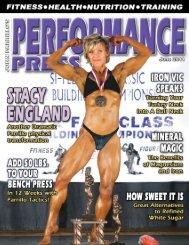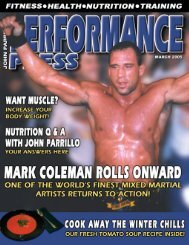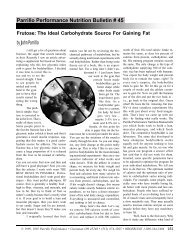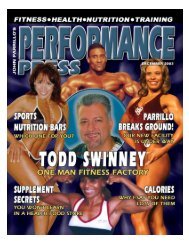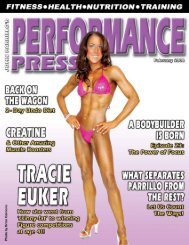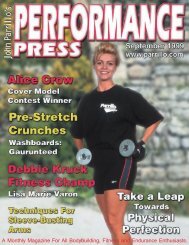Performance Press / September 2007 - Parrillo Performance
Performance Press / September 2007 - Parrillo Performance
Performance Press / September 2007 - Parrillo Performance
You also want an ePaper? Increase the reach of your titles
YUMPU automatically turns print PDFs into web optimized ePapers that Google loves.
JOHN PARRILLO’S PERFORMANCE PRESS<br />
a great energy source. So if you<br />
want to reduce carbs in your diet to<br />
manipulate hormone levels and promote<br />
fat metabolism it makes sense<br />
to replace those calories with another<br />
fuel source, namely CapTri ® .<br />
CapTri ® is a good choice because it<br />
is readily burned as fuel and won’t<br />
be stored as body fat, (5, 6). I suggest<br />
you ease into this slowly. Start<br />
by eliminating starchy carbs from<br />
your last meals of the day. Replace<br />
those lost calories from carbs with<br />
an equivalent number of calories<br />
from CapTri ® . CapTri ® actually has<br />
a higher thermogenic effect than<br />
carbohydrate, meaning that more<br />
of this dietary energy will be lost<br />
as body heat with less energy available<br />
for storage. This further promotes<br />
additional fat loss. Continue<br />
in this way until you reduce your<br />
daily carbohydrate grams to about<br />
half of what you normally consume.<br />
At this point you’ll be eating mostly<br />
protein, vegetables and CapTri ® .<br />
One of the most important points<br />
is to do your aerobics when you<br />
are relatively carb-depleted. This<br />
will cause you to burn more fat<br />
during your workout (because less<br />
Take 2 scoops of<br />
Hi-Protein Powder <br />
to prevent muscle<br />
loss, then do your<br />
aerobics.<br />
carbs are available). The best time<br />
is first thing in the morning before<br />
breakfast. Your glycogen stores<br />
are the lowest they’ll be all day, so<br />
you’ll rely more heavily on stored<br />
fat. Take two scoops of Hi-Protein<br />
Powder to prevent muscle loss,<br />
then do your aerobics.<br />
Another good time<br />
is right after weight<br />
training, because<br />
then you’re relatively<br />
glycogen depleted<br />
too. You should do<br />
moderate to fairly<br />
high intensity aerobics,<br />
so that you’re<br />
breathing hard and<br />
sweating. While<br />
it’s true you burn a<br />
higher percentage<br />
of calories from fat<br />
during low intensity<br />
aerobics, you will<br />
burn more grams of body fat if you<br />
perform high intensity aerobics,<br />
because you’ll burn so many more<br />
total calories. Also, if you do reasonably<br />
intense aerobics you will<br />
get the added benefits of increased<br />
vascular density and enhanced fat<br />
burning capacity. Increase the volume<br />
of aerobics progressively as<br />
you get leaner. If your fat loss plateaus<br />
the first thing to try is to do<br />
more intense aerobics. If that doesn’t<br />
work you should probably back off<br />
for a couple weeks, increase your<br />
calories, put on some muscle, and<br />
get your metabolism going again.<br />
If you want more details than I<br />
have been able to squeeze into<br />
this article, check out the <strong>Parrillo</strong><br />
<strong>Performance</strong> Nutrition Manual <br />
and the Body Stat Kit. I go into<br />
great detail about which foods to<br />
eat, which foods to avoid, and how<br />
to structure your meals. The Body<br />
Stat Kit contains instructions on<br />
exactly how to modify your training<br />
and nutrition program based<br />
on your weekly changes in body<br />
composition. It helps you remove<br />
the guesswork from your program.<br />
References<br />
1. Flatt JP. Dietary fat, carbohydrate<br />
balance, and weight maintenance:<br />
effects of exercise. Am. J.<br />
Clin. Nutr. 45: 296-306, 1987.<br />
2. Flatt JP. Use and storage of carbohydrate<br />
and fat. Am. J. Clin.<br />
Nutr. 61: 952s-959s, 1995.<br />
3. Swinburn B and Ravussin E. Energy<br />
balance or fat balance? Am. J.<br />
Clin. Nutr. 57: 766S-771S, 1993.<br />
4. Acheson KJ, Flatt JP, and Jequier<br />
E. Glycogen synthesis versus<br />
lipogenesis after a 500 gram carbohydrate<br />
meal in man. Metabolism<br />
31: 1234-1240, 1982.<br />
5. Baba N, Bracco EF, and Hashim<br />
SA. Enhanced thermogenesis and<br />
diminished deposition of fat in<br />
response to overfeeding with diet<br />
containing medium chain triglyceride.<br />
Am. J. Clin. Nutr. 35: 678-<br />
682, 1982.<br />
6. Bach AC and Babayan VK. Medium<br />
chain triglycerides: an update.<br />
Am. J. Clin. Nutr. 36: 950-<br />
962, 1982.<br />
22 <strong>September</strong> <strong>2007</strong> / <strong>Performance</strong> <strong>Press</strong> 1-800-344-3404 www.parrillo.com



